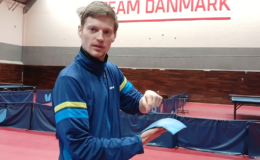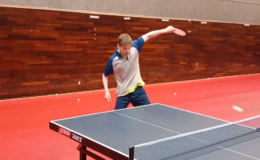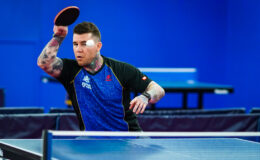By Larry Hodges, USATT Hall of Famer and Certified National Coach
Some of us remember the incredible topspins of U.S. Team Member Rick Seemiller (brother of Dan) back in the 1980s. He didn’t have great speed on his forehand loops. What he did have was more topspin than anyone in the U.S., and probably in the world. Even world-class players commented on this. When faced with this very slow, arcing ball that exploded off your racket, invariably going off, many an opponent called it “unreturnable.” Rick pulled off a huge upset over world #1 Mikael Appelgren, the best counterlooper in the world at the time, who over and over counterlooped off the end and then just stared at his racket in disbelief.
The game has evolved since then, with super-looping sponges, and players tend to go for as much speed as spin. But there’s nothing like a slow but spinny loop to mess up an opponent’s block or counterloop. You can learn the shot at any age – I’ve seen players learn to do this in their sixties.
Another big advantage of the slow loop is it gives you time to get back into position after the shot. You can do a slow forehand loop from the backhand side, and move back into position before the opponent can quick-block to the wide forehand. Also, the slowness of the shot means that most block returns will tend to come back more slowly, since the opponent can’t use your own speed against you. This gives you even more time for the next shot, as well as a softer ball to attack.
To do this shot you need a sheet of grippy inverted sponge, preferably one of the modern super-looping sponges. The shot is usually done against backspin, so you can use backspin in creating your own topspin. To execute the shot, it is important to let the ball drop farther down than usual, to below the table’s surface, perhaps as low as your knees. Bend your knees more than usual, and drop your playing shoulder and playing racket very low, with the racket tip pointing to the ground. (If you have knee or other leg problems, you can execute the shot almost as well by just dropping the racket very low from the shoulder.) Then whip the racket upward and forward, with a big wrist snap just before contact.
Contact the ball by just barely skimming it. At first you might feel like you’ll go off the end since much of your stroke is up, but if you barely graze the ball, it’ll have little forward motion, and so the topspin and gravity will pull it down. Arc the ball a little higher than usual, making it go deep on the table.
You can also do the shot on the backhand. Again, let the ball drop down more than usual, stroke more upward, and just skim the ball.
Note that there’s a world of difference between a spinny loop that lands short (easy to attack if the opponent doesn’t hesitate) and one that lands deep (very tricky to do anything with). Depth is key!
Done properly, your opponent will face a very spinny ball, coming at him relatively slowly (so he can’t use your own speed against you), and deep on the table. If he blocks, he has to punch the ball from deep on the court against a lot more topspin than he’s used to. If he counterloops, he’ll likely go off the end since he’s not used to such a slow, spinny ball. It can be done, but it’s not easy except perhaps at the highest levels.
Happy Topspinning!



